Implementing Sustainable FM Strategies at London City Airport
VerifiedAdded on 2020/05/04
|13
|2705
|72
AI Summary
London City Airport exemplifies a commitment to sustainability through its facilities management (FM) strategies. Serving 38 major business destinations across Europe and New York, LCY employs sustainable FM practices including the promotion of public transport over single-vehicle trips, adherence to ISO 14001 for Environmental Management Systems, and comprehensive recycling programs aimed at achieving zero waste. In response to increasing passenger numbers, the airport has strategically expanded its capacity while maintaining eco-friendly operations. London City Airport integrates Computer Aided Facilities Management (CAFM) since the 1990s and continuously adapts by collaborating with stakeholders to sustain environmental quality through initiatives like the Air Quality Action Plan. Despite challenges such as balancing outsourcing risks and internal service quality, LCY's dual approach of engaging in both external services and internal activities ensures customer satisfaction. As London City Airport progresses, its focus remains on harmonizing capacity expansion with sustainable practices, underscoring its role as a key business gateway and a model for airports globally.
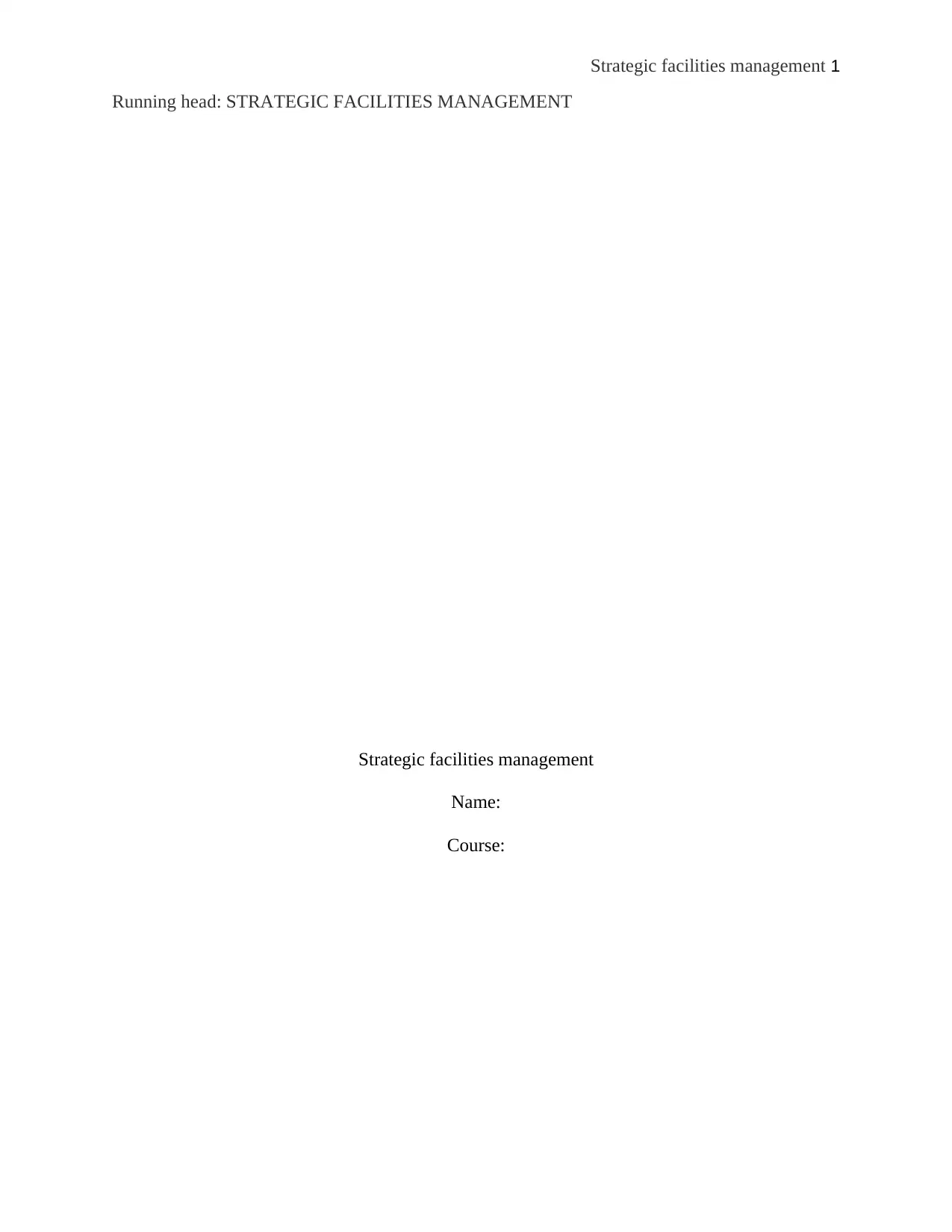
1Strategic facilities management
Running head: STRATEGIC FACILITIES MANAGEMENT
Strategic facilities management
Name:
Course:
Running head: STRATEGIC FACILITIES MANAGEMENT
Strategic facilities management
Name:
Course:
Paraphrase This Document
Need a fresh take? Get an instant paraphrase of this document with our AI Paraphraser
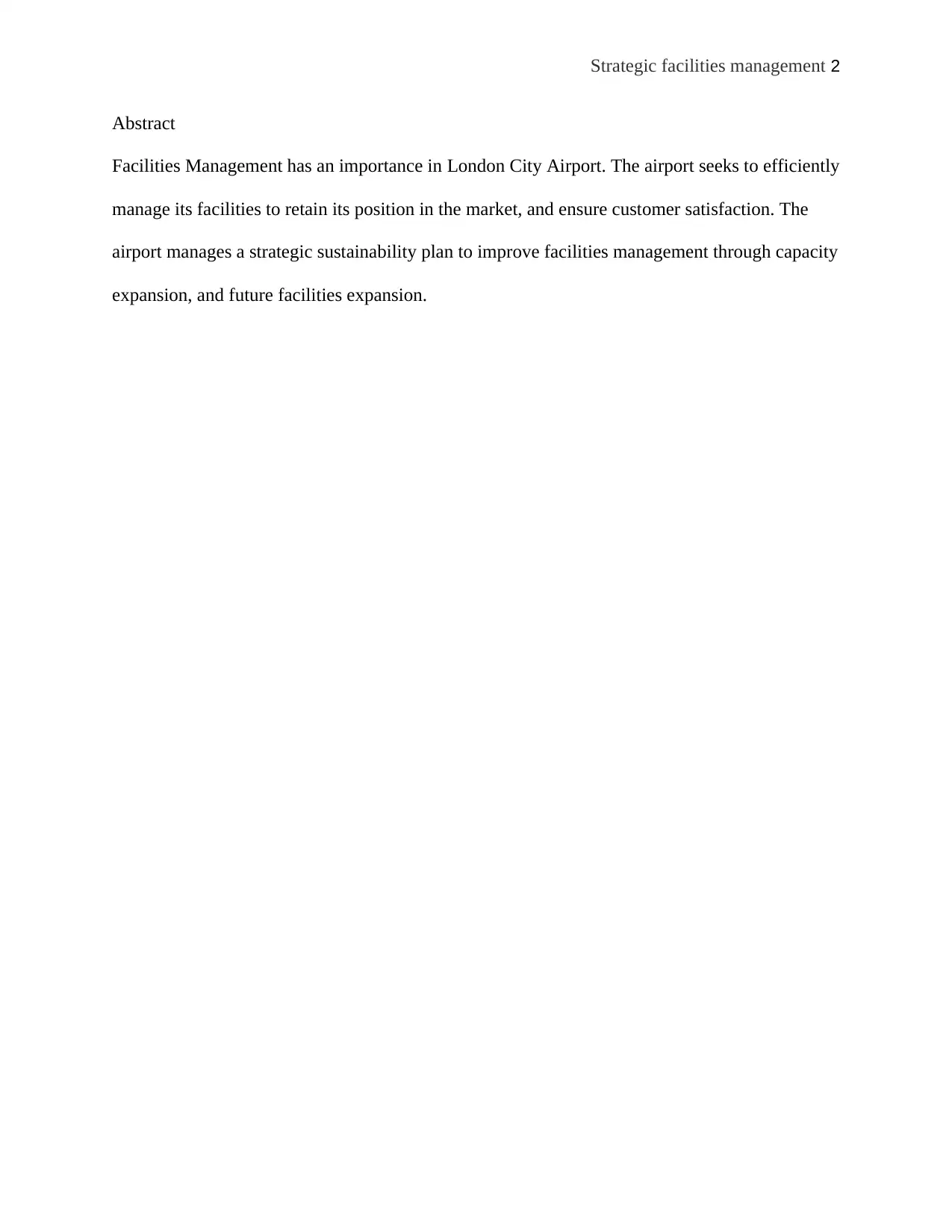
2Strategic facilities management
Abstract
Facilities Management has an importance in London City Airport. The airport seeks to efficiently
manage its facilities to retain its position in the market, and ensure customer satisfaction. The
airport manages a strategic sustainability plan to improve facilities management through capacity
expansion, and future facilities expansion.
Abstract
Facilities Management has an importance in London City Airport. The airport seeks to efficiently
manage its facilities to retain its position in the market, and ensure customer satisfaction. The
airport manages a strategic sustainability plan to improve facilities management through capacity
expansion, and future facilities expansion.
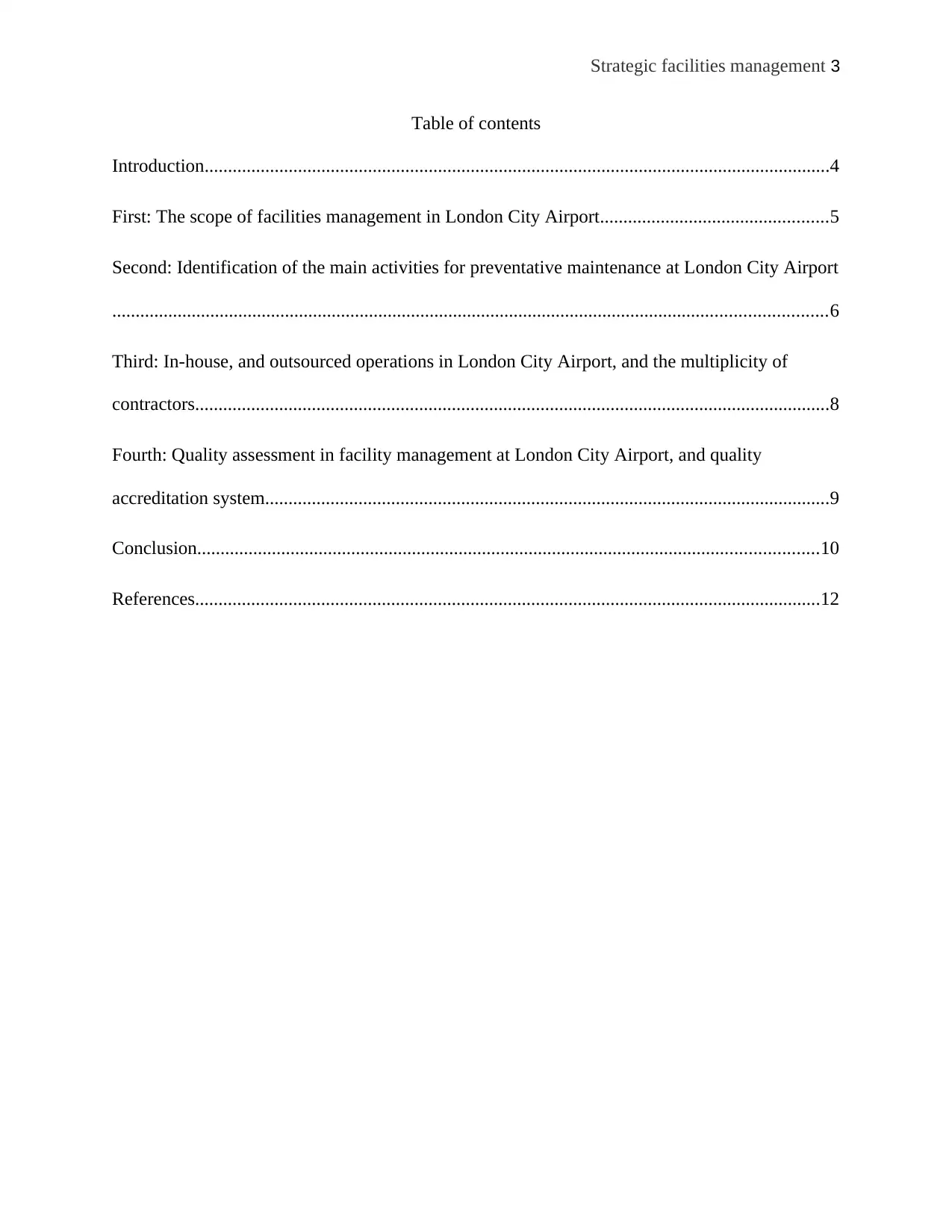
3Strategic facilities management
Table of contents
Introduction......................................................................................................................................4
First: The scope of facilities management in London City Airport.................................................5
Second: Identification of the main activities for preventative maintenance at London City Airport
.........................................................................................................................................................6
Third: In-house, and outsourced operations in London City Airport, and the multiplicity of
contractors........................................................................................................................................8
Fourth: Quality assessment in facility management at London City Airport, and quality
accreditation system.........................................................................................................................9
Conclusion.....................................................................................................................................10
References......................................................................................................................................12
Table of contents
Introduction......................................................................................................................................4
First: The scope of facilities management in London City Airport.................................................5
Second: Identification of the main activities for preventative maintenance at London City Airport
.........................................................................................................................................................6
Third: In-house, and outsourced operations in London City Airport, and the multiplicity of
contractors........................................................................................................................................8
Fourth: Quality assessment in facility management at London City Airport, and quality
accreditation system.........................................................................................................................9
Conclusion.....................................................................................................................................10
References......................................................................................................................................12
⊘ This is a preview!⊘
Do you want full access?
Subscribe today to unlock all pages.

Trusted by 1+ million students worldwide
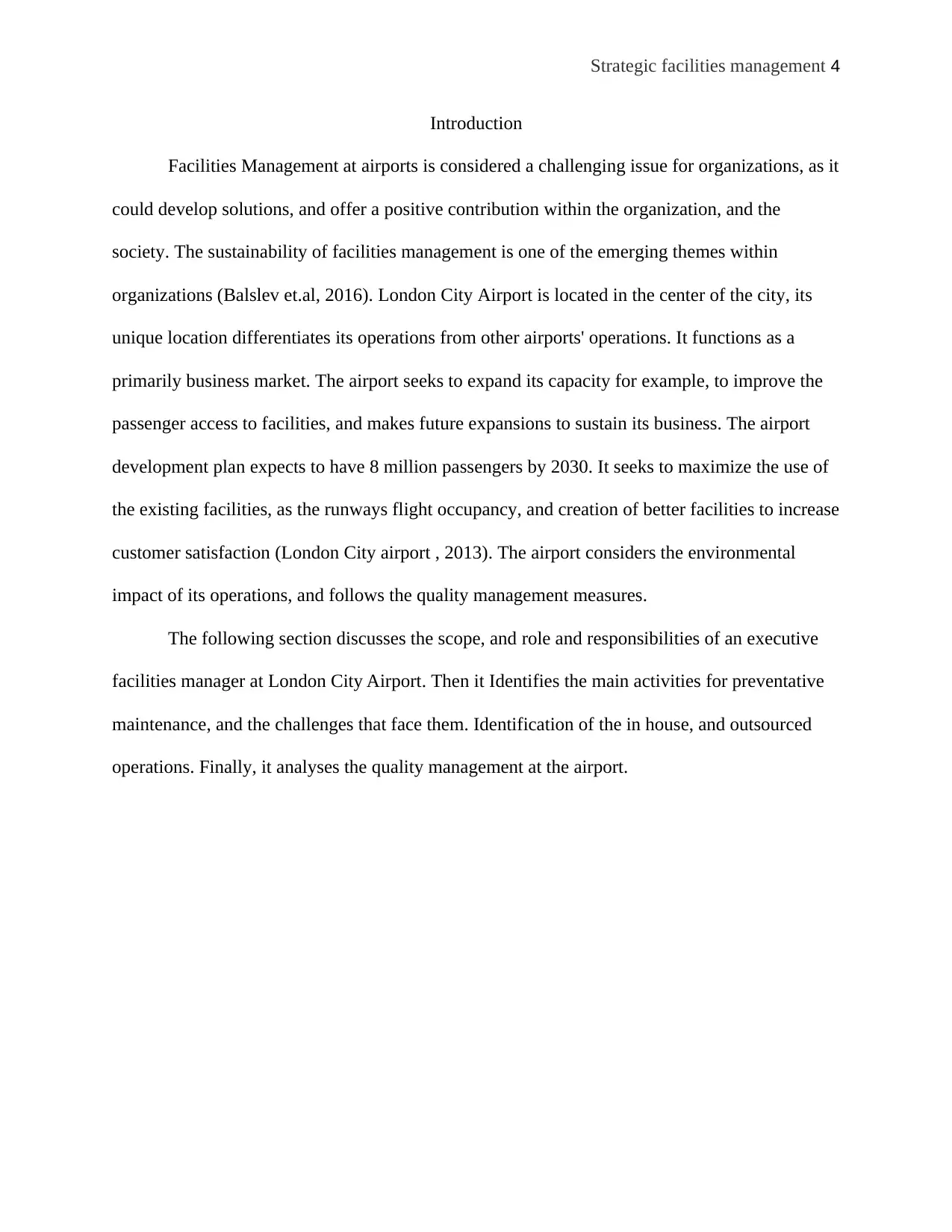
4Strategic facilities management
Introduction
Facilities Management at airports is considered a challenging issue for organizations, as it
could develop solutions, and offer a positive contribution within the organization, and the
society. The sustainability of facilities management is one of the emerging themes within
organizations (Balslev et.al, 2016). London City Airport is located in the center of the city, its
unique location differentiates its operations from other airports' operations. It functions as a
primarily business market. The airport seeks to expand its capacity for example, to improve the
passenger access to facilities, and makes future expansions to sustain its business. The airport
development plan expects to have 8 million passengers by 2030. It seeks to maximize the use of
the existing facilities, as the runways flight occupancy, and creation of better facilities to increase
customer satisfaction (London City airport , 2013). The airport considers the environmental
impact of its operations, and follows the quality management measures.
The following section discusses the scope, and role and responsibilities of an executive
facilities manager at London City Airport. Then it Identifies the main activities for preventative
maintenance, and the challenges that face them. Identification of the in house, and outsourced
operations. Finally, it analyses the quality management at the airport.
Introduction
Facilities Management at airports is considered a challenging issue for organizations, as it
could develop solutions, and offer a positive contribution within the organization, and the
society. The sustainability of facilities management is one of the emerging themes within
organizations (Balslev et.al, 2016). London City Airport is located in the center of the city, its
unique location differentiates its operations from other airports' operations. It functions as a
primarily business market. The airport seeks to expand its capacity for example, to improve the
passenger access to facilities, and makes future expansions to sustain its business. The airport
development plan expects to have 8 million passengers by 2030. It seeks to maximize the use of
the existing facilities, as the runways flight occupancy, and creation of better facilities to increase
customer satisfaction (London City airport , 2013). The airport considers the environmental
impact of its operations, and follows the quality management measures.
The following section discusses the scope, and role and responsibilities of an executive
facilities manager at London City Airport. Then it Identifies the main activities for preventative
maintenance, and the challenges that face them. Identification of the in house, and outsourced
operations. Finally, it analyses the quality management at the airport.
Paraphrase This Document
Need a fresh take? Get an instant paraphrase of this document with our AI Paraphraser
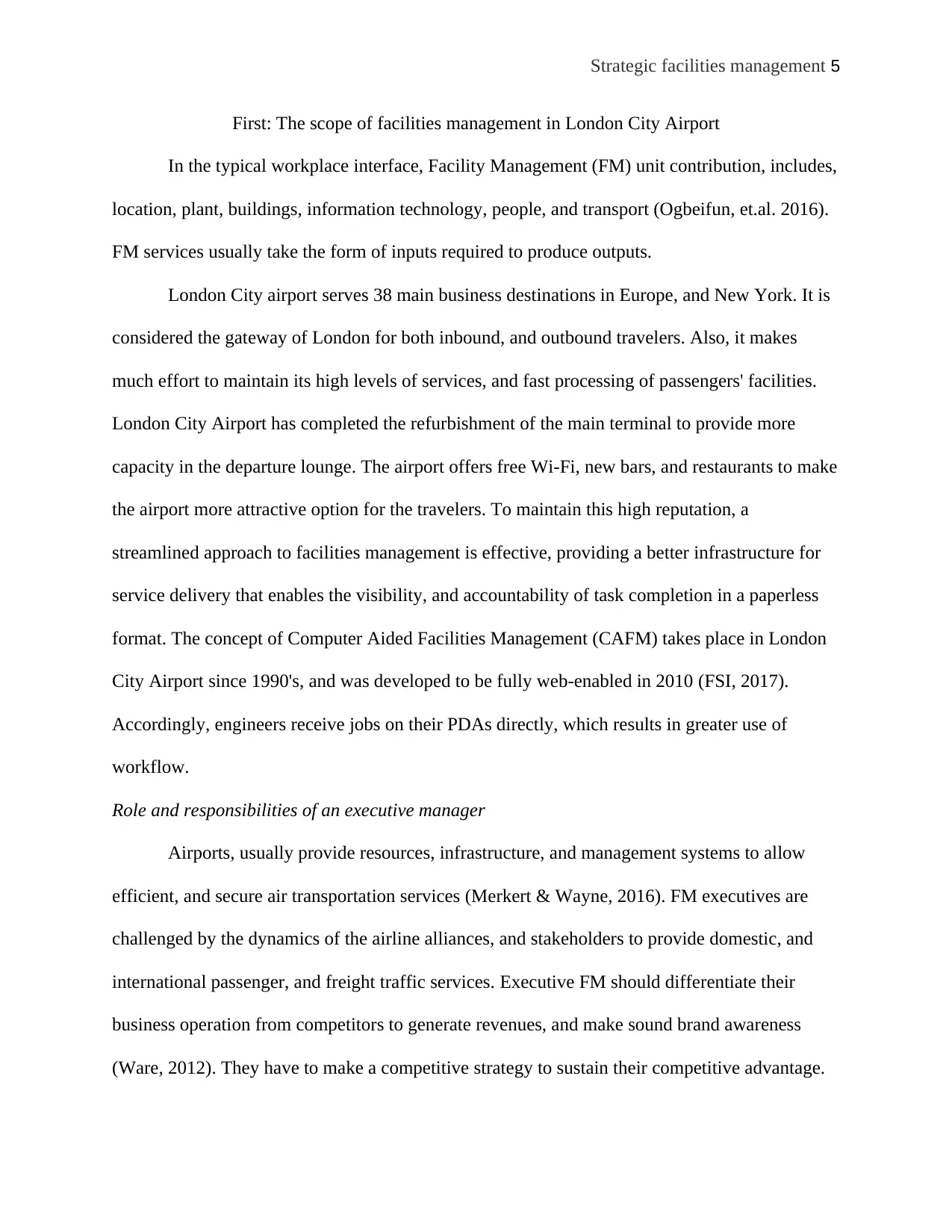
5Strategic facilities management
First: The scope of facilities management in London City Airport
In the typical workplace interface, Facility Management (FM) unit contribution, includes,
location, plant, buildings, information technology, people, and transport (Ogbeifun, et.al. 2016).
FM services usually take the form of inputs required to produce outputs.
London City airport serves 38 main business destinations in Europe, and New York. It is
considered the gateway of London for both inbound, and outbound travelers. Also, it makes
much effort to maintain its high levels of services, and fast processing of passengers' facilities.
London City Airport has completed the refurbishment of the main terminal to provide more
capacity in the departure lounge. The airport offers free Wi-Fi, new bars, and restaurants to make
the airport more attractive option for the travelers. To maintain this high reputation, a
streamlined approach to facilities management is effective, providing a better infrastructure for
service delivery that enables the visibility, and accountability of task completion in a paperless
format. The concept of Computer Aided Facilities Management (CAFM) takes place in London
City Airport since 1990's, and was developed to be fully web-enabled in 2010 (FSI, 2017).
Accordingly, engineers receive jobs on their PDAs directly, which results in greater use of
workflow.
Role and responsibilities of an executive manager
Airports, usually provide resources, infrastructure, and management systems to allow
efficient, and secure air transportation services (Merkert & Wayne, 2016). FM executives are
challenged by the dynamics of the airline alliances, and stakeholders to provide domestic, and
international passenger, and freight traffic services. Executive FM should differentiate their
business operation from competitors to generate revenues, and make sound brand awareness
(Ware, 2012). They have to make a competitive strategy to sustain their competitive advantage.
First: The scope of facilities management in London City Airport
In the typical workplace interface, Facility Management (FM) unit contribution, includes,
location, plant, buildings, information technology, people, and transport (Ogbeifun, et.al. 2016).
FM services usually take the form of inputs required to produce outputs.
London City airport serves 38 main business destinations in Europe, and New York. It is
considered the gateway of London for both inbound, and outbound travelers. Also, it makes
much effort to maintain its high levels of services, and fast processing of passengers' facilities.
London City Airport has completed the refurbishment of the main terminal to provide more
capacity in the departure lounge. The airport offers free Wi-Fi, new bars, and restaurants to make
the airport more attractive option for the travelers. To maintain this high reputation, a
streamlined approach to facilities management is effective, providing a better infrastructure for
service delivery that enables the visibility, and accountability of task completion in a paperless
format. The concept of Computer Aided Facilities Management (CAFM) takes place in London
City Airport since 1990's, and was developed to be fully web-enabled in 2010 (FSI, 2017).
Accordingly, engineers receive jobs on their PDAs directly, which results in greater use of
workflow.
Role and responsibilities of an executive manager
Airports, usually provide resources, infrastructure, and management systems to allow
efficient, and secure air transportation services (Merkert & Wayne, 2016). FM executives are
challenged by the dynamics of the airline alliances, and stakeholders to provide domestic, and
international passenger, and freight traffic services. Executive FM should differentiate their
business operation from competitors to generate revenues, and make sound brand awareness
(Ware, 2012). They have to make a competitive strategy to sustain their competitive advantage.
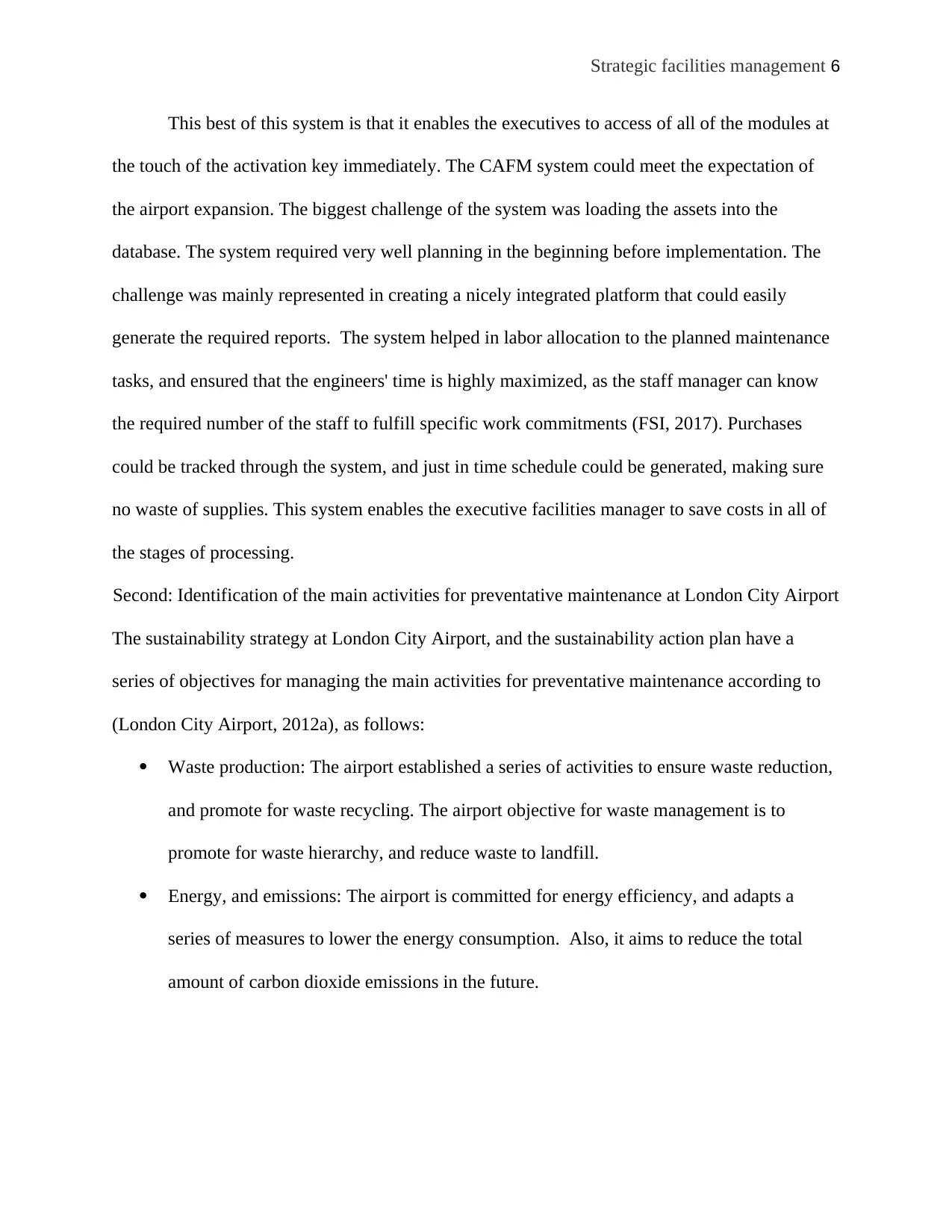
6Strategic facilities management
This best of this system is that it enables the executives to access of all of the modules at
the touch of the activation key immediately. The CAFM system could meet the expectation of
the airport expansion. The biggest challenge of the system was loading the assets into the
database. The system required very well planning in the beginning before implementation. The
challenge was mainly represented in creating a nicely integrated platform that could easily
generate the required reports. The system helped in labor allocation to the planned maintenance
tasks, and ensured that the engineers' time is highly maximized, as the staff manager can know
the required number of the staff to fulfill specific work commitments (FSI, 2017). Purchases
could be tracked through the system, and just in time schedule could be generated, making sure
no waste of supplies. This system enables the executive facilities manager to save costs in all of
the stages of processing.
Second: Identification of the main activities for preventative maintenance at London City Airport
The sustainability strategy at London City Airport, and the sustainability action plan have a
series of objectives for managing the main activities for preventative maintenance according to
(London City Airport, 2012a), as follows:
Waste production: The airport established a series of activities to ensure waste reduction,
and promote for waste recycling. The airport objective for waste management is to
promote for waste hierarchy, and reduce waste to landfill.
Energy, and emissions: The airport is committed for energy efficiency, and adapts a
series of measures to lower the energy consumption. Also, it aims to reduce the total
amount of carbon dioxide emissions in the future.
This best of this system is that it enables the executives to access of all of the modules at
the touch of the activation key immediately. The CAFM system could meet the expectation of
the airport expansion. The biggest challenge of the system was loading the assets into the
database. The system required very well planning in the beginning before implementation. The
challenge was mainly represented in creating a nicely integrated platform that could easily
generate the required reports. The system helped in labor allocation to the planned maintenance
tasks, and ensured that the engineers' time is highly maximized, as the staff manager can know
the required number of the staff to fulfill specific work commitments (FSI, 2017). Purchases
could be tracked through the system, and just in time schedule could be generated, making sure
no waste of supplies. This system enables the executive facilities manager to save costs in all of
the stages of processing.
Second: Identification of the main activities for preventative maintenance at London City Airport
The sustainability strategy at London City Airport, and the sustainability action plan have a
series of objectives for managing the main activities for preventative maintenance according to
(London City Airport, 2012a), as follows:
Waste production: The airport established a series of activities to ensure waste reduction,
and promote for waste recycling. The airport objective for waste management is to
promote for waste hierarchy, and reduce waste to landfill.
Energy, and emissions: The airport is committed for energy efficiency, and adapts a
series of measures to lower the energy consumption. Also, it aims to reduce the total
amount of carbon dioxide emissions in the future.
⊘ This is a preview!⊘
Do you want full access?
Subscribe today to unlock all pages.

Trusted by 1+ million students worldwide
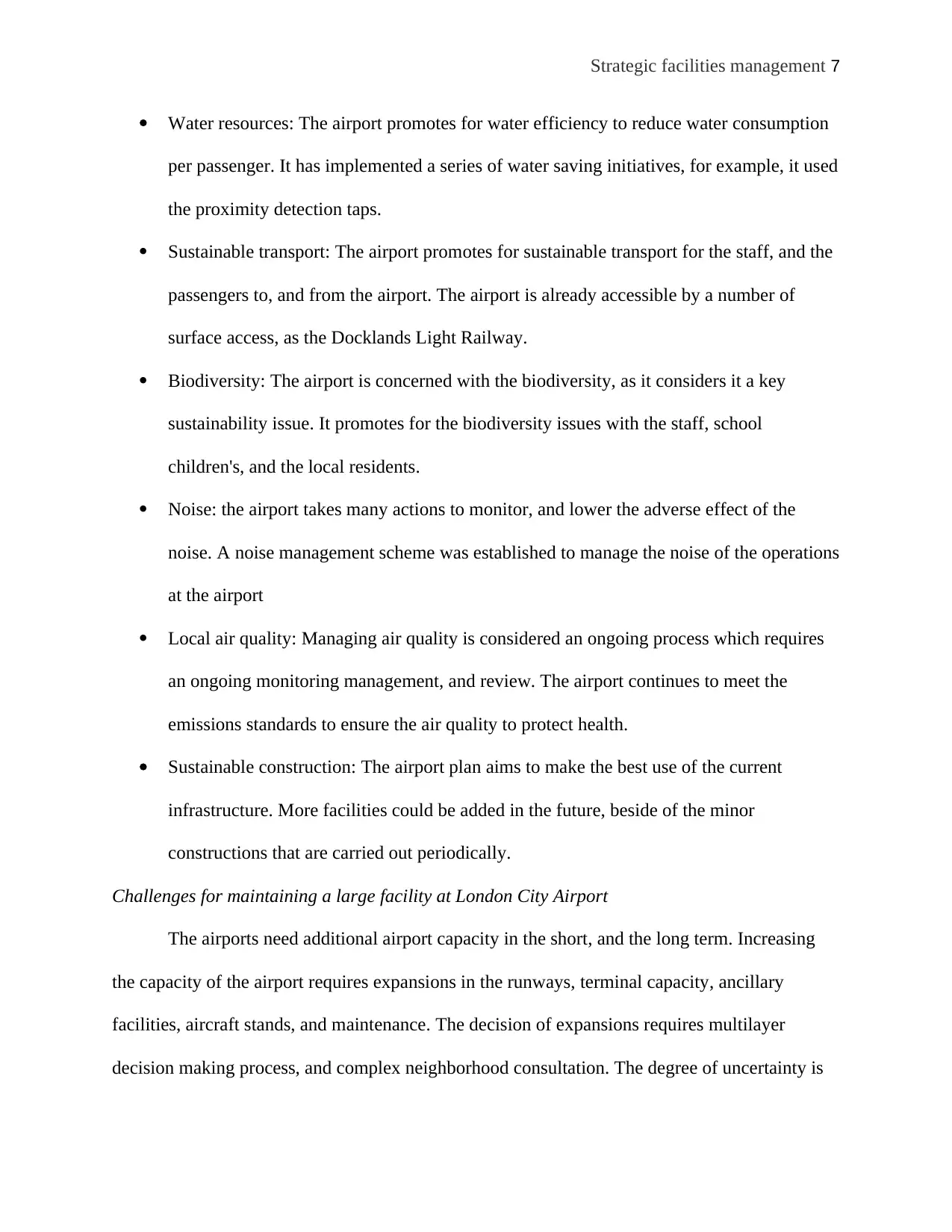
7Strategic facilities management
Water resources: The airport promotes for water efficiency to reduce water consumption
per passenger. It has implemented a series of water saving initiatives, for example, it used
the proximity detection taps.
Sustainable transport: The airport promotes for sustainable transport for the staff, and the
passengers to, and from the airport. The airport is already accessible by a number of
surface access, as the Docklands Light Railway.
Biodiversity: The airport is concerned with the biodiversity, as it considers it a key
sustainability issue. It promotes for the biodiversity issues with the staff, school
children's, and the local residents.
Noise: the airport takes many actions to monitor, and lower the adverse effect of the
noise. A noise management scheme was established to manage the noise of the operations
at the airport
Local air quality: Managing air quality is considered an ongoing process which requires
an ongoing monitoring management, and review. The airport continues to meet the
emissions standards to ensure the air quality to protect health.
Sustainable construction: The airport plan aims to make the best use of the current
infrastructure. More facilities could be added in the future, beside of the minor
constructions that are carried out periodically.
Challenges for maintaining a large facility at London City Airport
The airports need additional airport capacity in the short, and the long term. Increasing
the capacity of the airport requires expansions in the runways, terminal capacity, ancillary
facilities, aircraft stands, and maintenance. The decision of expansions requires multilayer
decision making process, and complex neighborhood consultation. The degree of uncertainty is
Water resources: The airport promotes for water efficiency to reduce water consumption
per passenger. It has implemented a series of water saving initiatives, for example, it used
the proximity detection taps.
Sustainable transport: The airport promotes for sustainable transport for the staff, and the
passengers to, and from the airport. The airport is already accessible by a number of
surface access, as the Docklands Light Railway.
Biodiversity: The airport is concerned with the biodiversity, as it considers it a key
sustainability issue. It promotes for the biodiversity issues with the staff, school
children's, and the local residents.
Noise: the airport takes many actions to monitor, and lower the adverse effect of the
noise. A noise management scheme was established to manage the noise of the operations
at the airport
Local air quality: Managing air quality is considered an ongoing process which requires
an ongoing monitoring management, and review. The airport continues to meet the
emissions standards to ensure the air quality to protect health.
Sustainable construction: The airport plan aims to make the best use of the current
infrastructure. More facilities could be added in the future, beside of the minor
constructions that are carried out periodically.
Challenges for maintaining a large facility at London City Airport
The airports need additional airport capacity in the short, and the long term. Increasing
the capacity of the airport requires expansions in the runways, terminal capacity, ancillary
facilities, aircraft stands, and maintenance. The decision of expansions requires multilayer
decision making process, and complex neighborhood consultation. The degree of uncertainty is
Paraphrase This Document
Need a fresh take? Get an instant paraphrase of this document with our AI Paraphraser
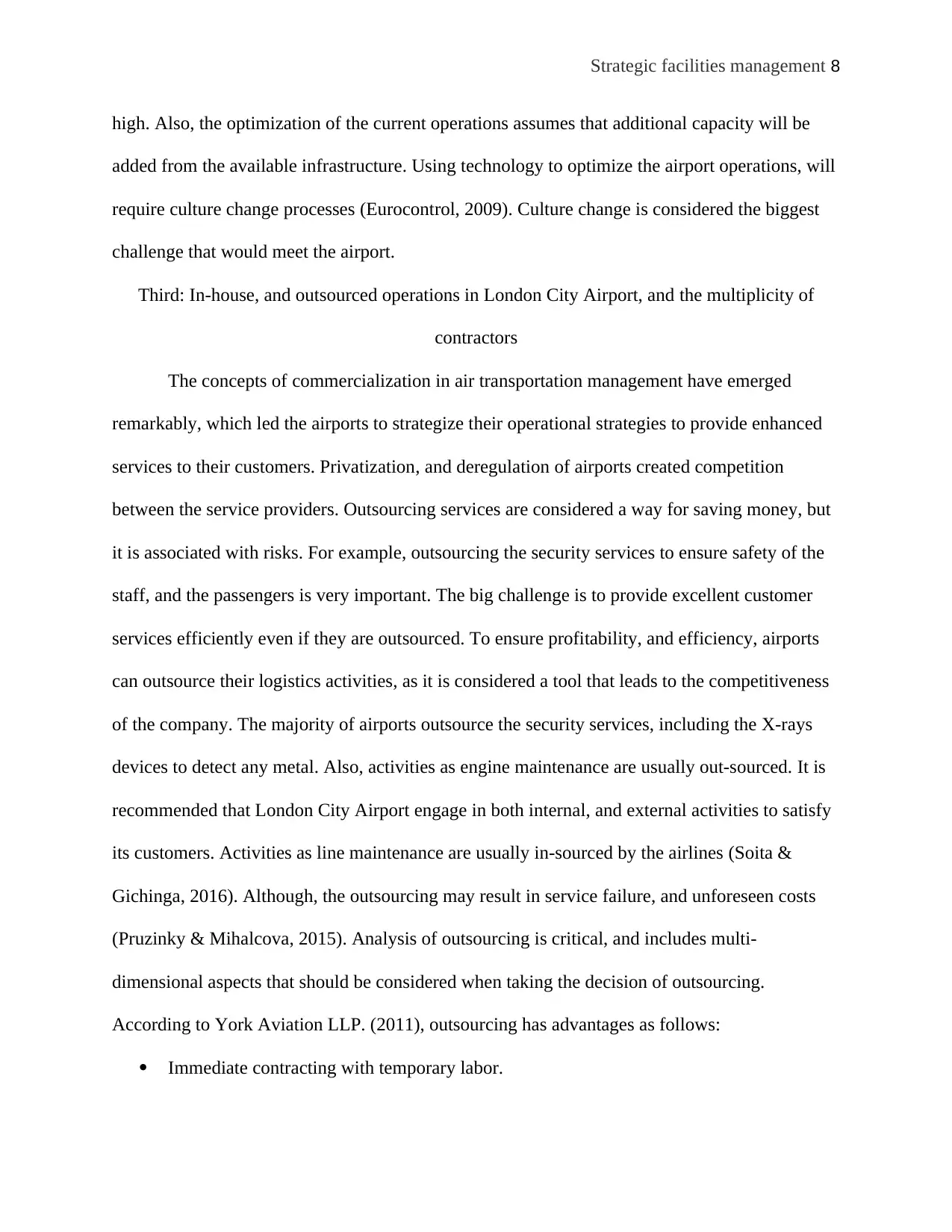
8Strategic facilities management
high. Also, the optimization of the current operations assumes that additional capacity will be
added from the available infrastructure. Using technology to optimize the airport operations, will
require culture change processes (Eurocontrol, 2009). Culture change is considered the biggest
challenge that would meet the airport.
Third: In-house, and outsourced operations in London City Airport, and the multiplicity of
contractors
The concepts of commercialization in air transportation management have emerged
remarkably, which led the airports to strategize their operational strategies to provide enhanced
services to their customers. Privatization, and deregulation of airports created competition
between the service providers. Outsourcing services are considered a way for saving money, but
it is associated with risks. For example, outsourcing the security services to ensure safety of the
staff, and the passengers is very important. The big challenge is to provide excellent customer
services efficiently even if they are outsourced. To ensure profitability, and efficiency, airports
can outsource their logistics activities, as it is considered a tool that leads to the competitiveness
of the company. The majority of airports outsource the security services, including the X-rays
devices to detect any metal. Also, activities as engine maintenance are usually out-sourced. It is
recommended that London City Airport engage in both internal, and external activities to satisfy
its customers. Activities as line maintenance are usually in-sourced by the airlines (Soita &
Gichinga, 2016). Although, the outsourcing may result in service failure, and unforeseen costs
(Pruzinky & Mihalcova, 2015). Analysis of outsourcing is critical, and includes multi-
dimensional aspects that should be considered when taking the decision of outsourcing.
According to York Aviation LLP. (2011), outsourcing has advantages as follows:
Immediate contracting with temporary labor.
high. Also, the optimization of the current operations assumes that additional capacity will be
added from the available infrastructure. Using technology to optimize the airport operations, will
require culture change processes (Eurocontrol, 2009). Culture change is considered the biggest
challenge that would meet the airport.
Third: In-house, and outsourced operations in London City Airport, and the multiplicity of
contractors
The concepts of commercialization in air transportation management have emerged
remarkably, which led the airports to strategize their operational strategies to provide enhanced
services to their customers. Privatization, and deregulation of airports created competition
between the service providers. Outsourcing services are considered a way for saving money, but
it is associated with risks. For example, outsourcing the security services to ensure safety of the
staff, and the passengers is very important. The big challenge is to provide excellent customer
services efficiently even if they are outsourced. To ensure profitability, and efficiency, airports
can outsource their logistics activities, as it is considered a tool that leads to the competitiveness
of the company. The majority of airports outsource the security services, including the X-rays
devices to detect any metal. Also, activities as engine maintenance are usually out-sourced. It is
recommended that London City Airport engage in both internal, and external activities to satisfy
its customers. Activities as line maintenance are usually in-sourced by the airlines (Soita &
Gichinga, 2016). Although, the outsourcing may result in service failure, and unforeseen costs
(Pruzinky & Mihalcova, 2015). Analysis of outsourcing is critical, and includes multi-
dimensional aspects that should be considered when taking the decision of outsourcing.
According to York Aviation LLP. (2011), outsourcing has advantages as follows:
Immediate contracting with temporary labor.
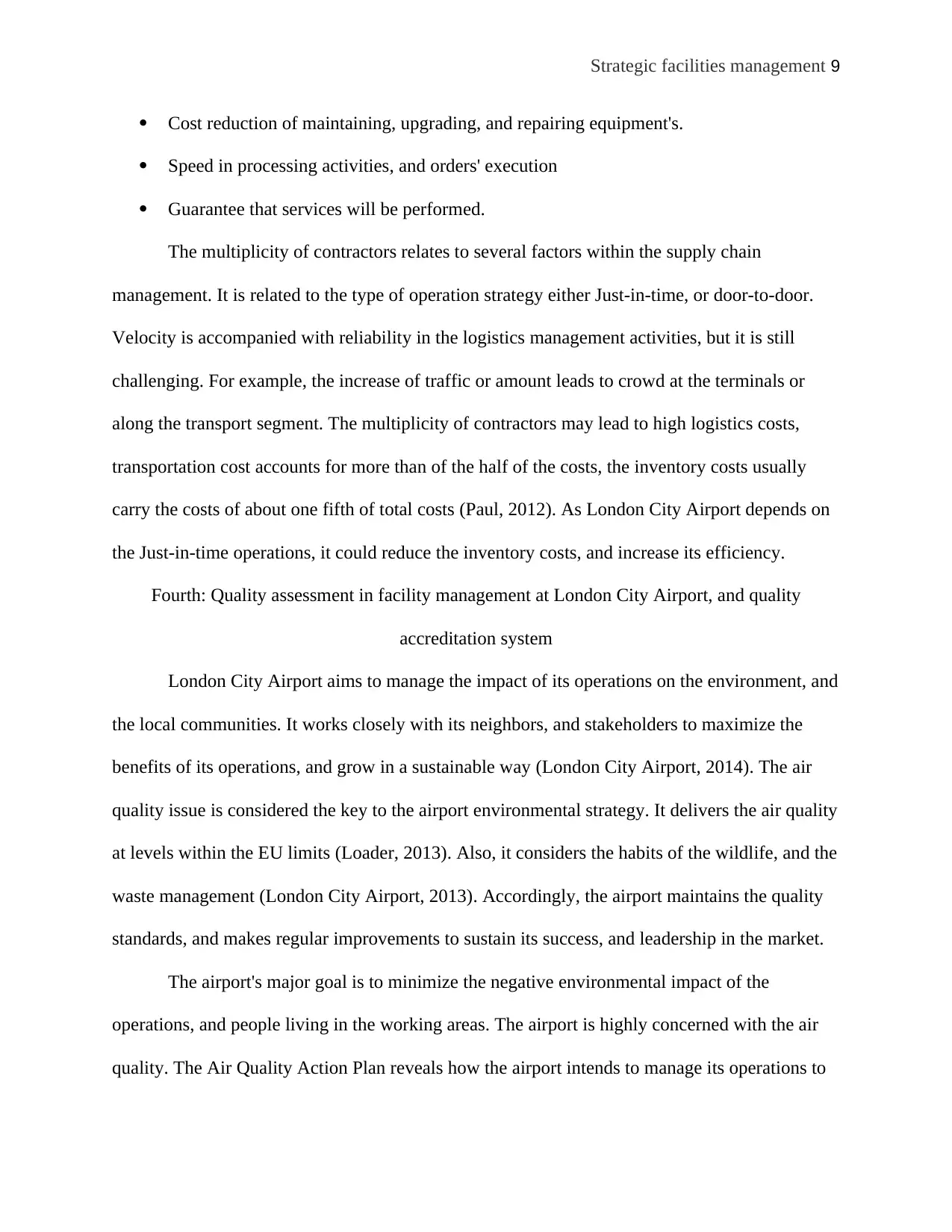
9Strategic facilities management
Cost reduction of maintaining, upgrading, and repairing equipment's.
Speed in processing activities, and orders' execution
Guarantee that services will be performed.
The multiplicity of contractors relates to several factors within the supply chain
management. It is related to the type of operation strategy either Just-in-time, or door-to-door.
Velocity is accompanied with reliability in the logistics management activities, but it is still
challenging. For example, the increase of traffic or amount leads to crowd at the terminals or
along the transport segment. The multiplicity of contractors may lead to high logistics costs,
transportation cost accounts for more than of the half of the costs, the inventory costs usually
carry the costs of about one fifth of total costs (Paul, 2012). As London City Airport depends on
the Just-in-time operations, it could reduce the inventory costs, and increase its efficiency.
Fourth: Quality assessment in facility management at London City Airport, and quality
accreditation system
London City Airport aims to manage the impact of its operations on the environment, and
the local communities. It works closely with its neighbors, and stakeholders to maximize the
benefits of its operations, and grow in a sustainable way (London City Airport, 2014). The air
quality issue is considered the key to the airport environmental strategy. It delivers the air quality
at levels within the EU limits (Loader, 2013). Also, it considers the habits of the wildlife, and the
waste management (London City Airport, 2013). Accordingly, the airport maintains the quality
standards, and makes regular improvements to sustain its success, and leadership in the market.
The airport's major goal is to minimize the negative environmental impact of the
operations, and people living in the working areas. The airport is highly concerned with the air
quality. The Air Quality Action Plan reveals how the airport intends to manage its operations to
Cost reduction of maintaining, upgrading, and repairing equipment's.
Speed in processing activities, and orders' execution
Guarantee that services will be performed.
The multiplicity of contractors relates to several factors within the supply chain
management. It is related to the type of operation strategy either Just-in-time, or door-to-door.
Velocity is accompanied with reliability in the logistics management activities, but it is still
challenging. For example, the increase of traffic or amount leads to crowd at the terminals or
along the transport segment. The multiplicity of contractors may lead to high logistics costs,
transportation cost accounts for more than of the half of the costs, the inventory costs usually
carry the costs of about one fifth of total costs (Paul, 2012). As London City Airport depends on
the Just-in-time operations, it could reduce the inventory costs, and increase its efficiency.
Fourth: Quality assessment in facility management at London City Airport, and quality
accreditation system
London City Airport aims to manage the impact of its operations on the environment, and
the local communities. It works closely with its neighbors, and stakeholders to maximize the
benefits of its operations, and grow in a sustainable way (London City Airport, 2014). The air
quality issue is considered the key to the airport environmental strategy. It delivers the air quality
at levels within the EU limits (Loader, 2013). Also, it considers the habits of the wildlife, and the
waste management (London City Airport, 2013). Accordingly, the airport maintains the quality
standards, and makes regular improvements to sustain its success, and leadership in the market.
The airport's major goal is to minimize the negative environmental impact of the
operations, and people living in the working areas. The airport is highly concerned with the air
quality. The Air Quality Action Plan reveals how the airport intends to manage its operations to
⊘ This is a preview!⊘
Do you want full access?
Subscribe today to unlock all pages.

Trusted by 1+ million students worldwide
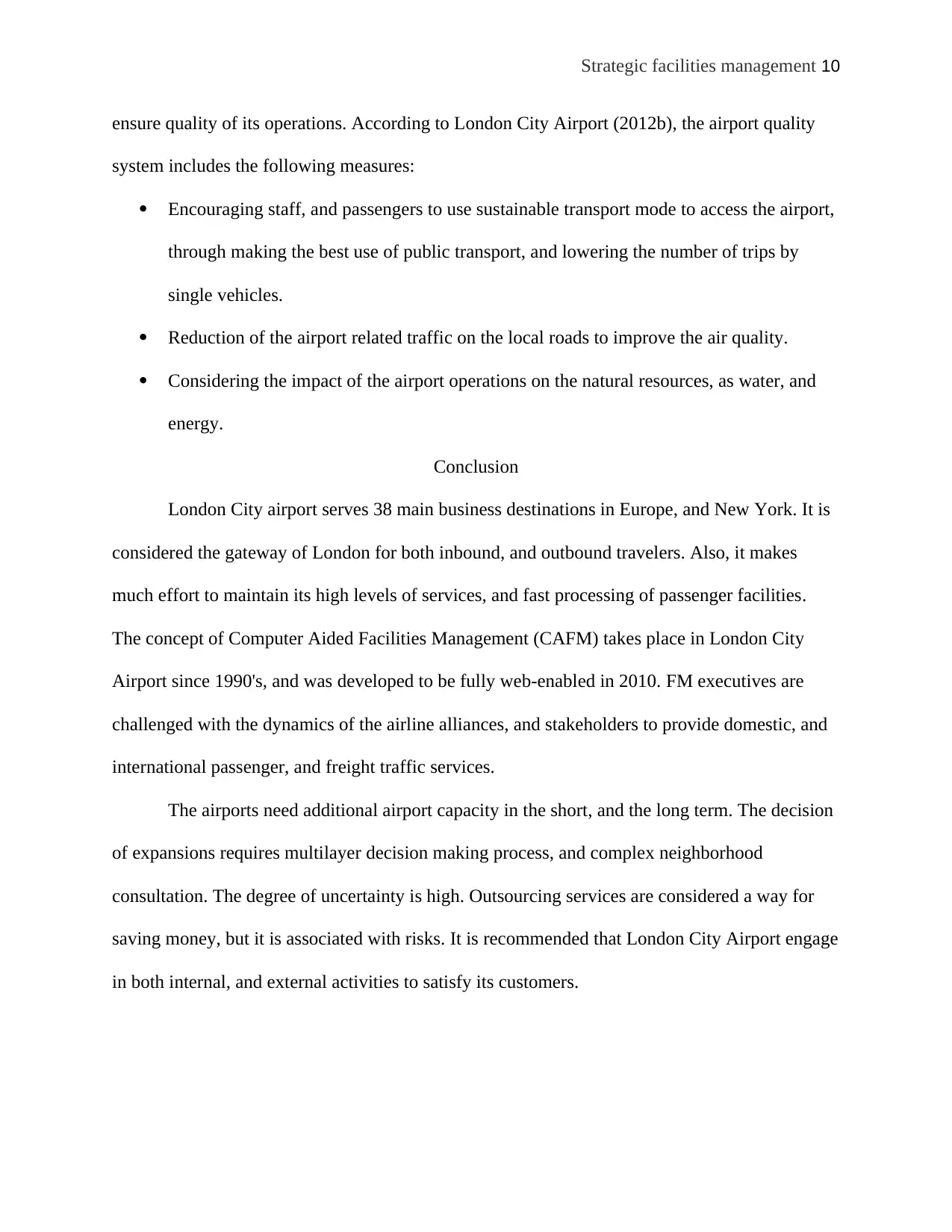
10Strategic facilities management
ensure quality of its operations. According to London City Airport (2012b), the airport quality
system includes the following measures:
Encouraging staff, and passengers to use sustainable transport mode to access the airport,
through making the best use of public transport, and lowering the number of trips by
single vehicles.
Reduction of the airport related traffic on the local roads to improve the air quality.
Considering the impact of the airport operations on the natural resources, as water, and
energy.
Conclusion
London City airport serves 38 main business destinations in Europe, and New York. It is
considered the gateway of London for both inbound, and outbound travelers. Also, it makes
much effort to maintain its high levels of services, and fast processing of passenger facilities.
The concept of Computer Aided Facilities Management (CAFM) takes place in London City
Airport since 1990's, and was developed to be fully web-enabled in 2010. FM executives are
challenged with the dynamics of the airline alliances, and stakeholders to provide domestic, and
international passenger, and freight traffic services.
The airports need additional airport capacity in the short, and the long term. The decision
of expansions requires multilayer decision making process, and complex neighborhood
consultation. The degree of uncertainty is high. Outsourcing services are considered a way for
saving money, but it is associated with risks. It is recommended that London City Airport engage
in both internal, and external activities to satisfy its customers.
ensure quality of its operations. According to London City Airport (2012b), the airport quality
system includes the following measures:
Encouraging staff, and passengers to use sustainable transport mode to access the airport,
through making the best use of public transport, and lowering the number of trips by
single vehicles.
Reduction of the airport related traffic on the local roads to improve the air quality.
Considering the impact of the airport operations on the natural resources, as water, and
energy.
Conclusion
London City airport serves 38 main business destinations in Europe, and New York. It is
considered the gateway of London for both inbound, and outbound travelers. Also, it makes
much effort to maintain its high levels of services, and fast processing of passenger facilities.
The concept of Computer Aided Facilities Management (CAFM) takes place in London City
Airport since 1990's, and was developed to be fully web-enabled in 2010. FM executives are
challenged with the dynamics of the airline alliances, and stakeholders to provide domestic, and
international passenger, and freight traffic services.
The airports need additional airport capacity in the short, and the long term. The decision
of expansions requires multilayer decision making process, and complex neighborhood
consultation. The degree of uncertainty is high. Outsourcing services are considered a way for
saving money, but it is associated with risks. It is recommended that London City Airport engage
in both internal, and external activities to satisfy its customers.
Paraphrase This Document
Need a fresh take? Get an instant paraphrase of this document with our AI Paraphraser

11Strategic facilities management
London City Airport works closely with its neighbors, and stakeholders to maximize the
benefits of its operations, and grow in a sustainable way. The Air Quality Action Plan reveals
that the airport intends to manage its operations to ensure quality of its operations.
London City Airport works closely with its neighbors, and stakeholders to maximize the
benefits of its operations, and grow in a sustainable way. The Air Quality Action Plan reveals
that the airport intends to manage its operations to ensure quality of its operations.
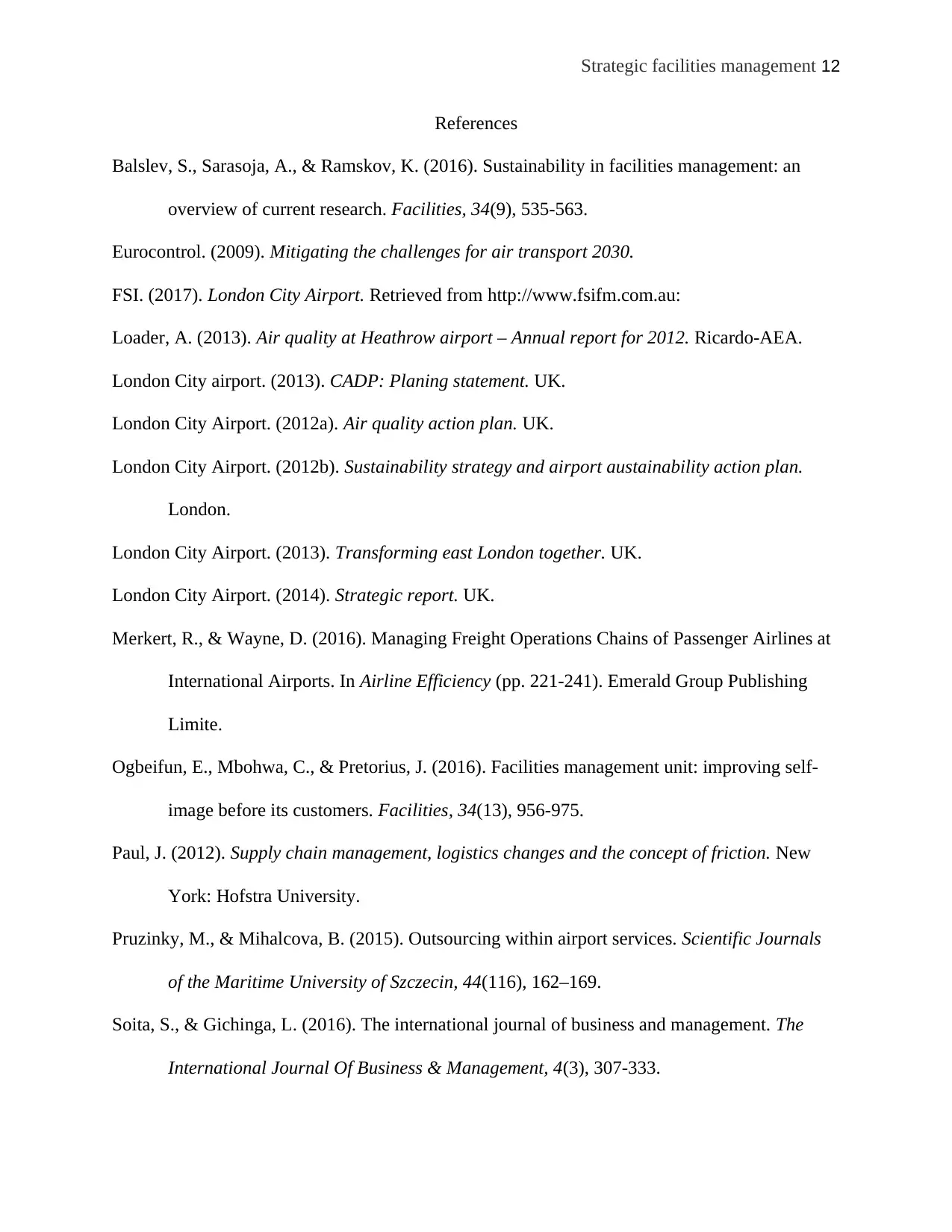
12Strategic facilities management
References
Balslev, S., Sarasoja, A., & Ramskov, K. (2016). Sustainability in facilities management: an
overview of current research. Facilities, 34(9), 535-563.
Eurocontrol. (2009). Mitigating the challenges for air transport 2030.
FSI. (2017). London City Airport. Retrieved from http://www.fsifm.com.au:
Loader, A. (2013). Air quality at Heathrow airport – Annual report for 2012. Ricardo-AEA.
London City airport. (2013). CADP: Planing statement. UK.
London City Airport. (2012a). Air quality action plan. UK.
London City Airport. (2012b). Sustainability strategy and airport austainability action plan.
London.
London City Airport. (2013). Transforming east London together. UK.
London City Airport. (2014). Strategic report. UK.
Merkert, R., & Wayne, D. (2016). Managing Freight Operations Chains of Passenger Airlines at
International Airports. In Airline Efficiency (pp. 221-241). Emerald Group Publishing
Limite.
Ogbeifun, E., Mbohwa, C., & Pretorius, J. (2016). Facilities management unit: improving self-
image before its customers. Facilities, 34(13), 956-975.
Paul, J. (2012). Supply chain management, logistics changes and the concept of friction. New
York: Hofstra University.
Pruzinky, M., & Mihalcova, B. (2015). Outsourcing within airport services. Scientific Journals
of the Maritime University of Szczecin, 44(116), 162–169.
Soita, S., & Gichinga, L. (2016). The international journal of business and management. The
International Journal Of Business & Management, 4(3), 307-333.
References
Balslev, S., Sarasoja, A., & Ramskov, K. (2016). Sustainability in facilities management: an
overview of current research. Facilities, 34(9), 535-563.
Eurocontrol. (2009). Mitigating the challenges for air transport 2030.
FSI. (2017). London City Airport. Retrieved from http://www.fsifm.com.au:
Loader, A. (2013). Air quality at Heathrow airport – Annual report for 2012. Ricardo-AEA.
London City airport. (2013). CADP: Planing statement. UK.
London City Airport. (2012a). Air quality action plan. UK.
London City Airport. (2012b). Sustainability strategy and airport austainability action plan.
London.
London City Airport. (2013). Transforming east London together. UK.
London City Airport. (2014). Strategic report. UK.
Merkert, R., & Wayne, D. (2016). Managing Freight Operations Chains of Passenger Airlines at
International Airports. In Airline Efficiency (pp. 221-241). Emerald Group Publishing
Limite.
Ogbeifun, E., Mbohwa, C., & Pretorius, J. (2016). Facilities management unit: improving self-
image before its customers. Facilities, 34(13), 956-975.
Paul, J. (2012). Supply chain management, logistics changes and the concept of friction. New
York: Hofstra University.
Pruzinky, M., & Mihalcova, B. (2015). Outsourcing within airport services. Scientific Journals
of the Maritime University of Szczecin, 44(116), 162–169.
Soita, S., & Gichinga, L. (2016). The international journal of business and management. The
International Journal Of Business & Management, 4(3), 307-333.
⊘ This is a preview!⊘
Do you want full access?
Subscribe today to unlock all pages.

Trusted by 1+ million students worldwide
1 out of 13
Related Documents
Your All-in-One AI-Powered Toolkit for Academic Success.
+13062052269
info@desklib.com
Available 24*7 on WhatsApp / Email
![[object Object]](/_next/static/media/star-bottom.7253800d.svg)
Unlock your academic potential
Copyright © 2020–2025 A2Z Services. All Rights Reserved. Developed and managed by ZUCOL.





